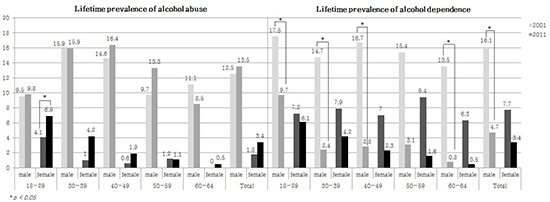1. Helzer JE, Canino GJ, Yeh EK, Bland RC, Lee CK, Hwu HG, Newman S. Alcoholism--North America and Asia. A comparison of population surveys with the Diagnostic Interview Schedule. Arch Gen Psychiatry. 1990; 47:313–319.
2. Hahm BJ, Cho MJ. Prevalence of alcohol use disorder in a South Korean community--changes in the pattern of prevalence over the past 15 years. Soc Psychiatry Psychiatr Epidemiol. 2005; 40:114–119.
3. Lee CK, Kwak YS, Yamamoto J, Rhee H, Kim YS, Han JH, Choi JO, Lee YH. Psychiatric epidemiology in Korea. Part I: Gender and age differences in Seoul. J Nerv Ment Dis. 1990; 178:242–246.
4. Bourdon KH, Rae DS, Locke BZ, Narrow WE, Regier DA. Estimating the prevalence of mental disorders in U.S. adults from the Epidemiologic Catchment Area Survey. Public Health Rep. 1992; 107:663–668.
5. Compton WM 3rd, Helzer JE, Hwu HG, Yeh EK, McEvoy L, Tipp JE, Spitznagel EL. New methods in cross-cultural psychiatry: psychiatric illness in Taiwan and the United States. Am J Psychiatry. 1991; 148:1697–1704.
6. Regier DA, Myers JK, Kramer M, Robins LN, Blazer DG, Hough RL, Eaton WW, Locke BZ. The NIMH Epidemiologic Catchment Area program. Historical context, major objectives, and study population characteristics. Arch Gen Psychiatry. 1984; 41:934–941.
7. Robins LN, Helzer JE, Croughan J, Ratcliff KS. National Institute of Mental Health Diagnostic Interview Schedule. Its history, characteristics, and validity. Arch Gen Psychiatry. 1981; 38:381–389.
8. Robins LN, Wing J, Wittchen HU, Helzer JE, Babor TF, Burke J, Farmer A, Jablenski A, Pickens R, Regier DA, et al. The Composite International Diagnostic Interview. An epidemiologic Instrument suitable for use in conjunction with different diagnostic systems and in different cultures. Arch Gen Psychiatry. 1988; 45:1069–1077.
9. Keyes KM, Li G, Hasin DS. Birth cohort effects and gender differences in alcohol epidemiology: a review and synthesis. Alcohol Clin Exp Res. 2011; 35:2101–2112.
10. Robins LN, Regier DA. Alcohol abuse and dependence. In : Helzer JE, Burnam A, McEvoy LT, editors. Psychiatric disorders in America: the epidemiologic catchment area study. New York: Free Press;1991.
11. Kessler RC, McGonagle KA, Zhao S, Nelson CB, Hughes M, Eshleman S, Wittchen HU, Kendler KS. Lifetime and 12-month prevalence of DSM-III-R psychiatric disorders in the United States. Results from the National Comorbidity Survey. Arch Gen Psychiatry. 1994; 51:8–19.
12. Grant BF, Dawson DA, Stinson FS, Chou SP, Dufour MC, Pickering RP. The 12-month prevalence and trends in DSM-IV alcohol abuse and dependence: United States, 1991-1992 and 2001-2002. Drug Alcohol Depend. 2004; 74:223–234.
13. Grant BF, Harford TC, Dawson DA, Chou SP, Dufour M, Pickering R. Prevalence of DSM-IV alcohol abuse and dependence: United States, 1992. Alcohol Health Res World. 1994; 18:243–248.
14. Grant BF, Moore TC, Kaplan KD. Source and accuracy statement: Wave 1 National Epidemiologic Survey on Alcohol and Related Conditions (NESARC). Bethesda: National Institute on Alcohol Abuse and Alcoholism;2003.
16. Cho MJ, Kim JK, Jeon HJ, Suh T, Chung IW, Hong JP, Bae JN, Lee DW, Park JI, Cho SJ, et al. Lifetime and 12-month prevalence of DSM-IV psychiatric disorders among Korean adults. J Nerv Ment Dis. 2007; 195:203–210.
17. Lee HK, Chou SP, Cho MJ, Park JI, Dawson DA, Grant BF. The prevalence and correlates of alcohol use disorders in the United States and Korea--a cross-national comparative study. Alcohol. 2010; 44:297–306.
19. Rice JP, Neuman RJ, Saccone NL, Corbett J, Rochberg N, Hesselbrock V, Bucholz KK, McGuffin P, Reich T. Age and birth cohort effects on rates of alcohol dependence. Alcohol Clin Exp Res. 2003; 27:93–99.
20. Seedat S, Scott KM, Angermeyer MC, Berglund P, Bromet EJ, Brugha TS, Demyttenaere K, de Girolamo G, Haro JM, Jin R, et al. Cross-national associations between gender and mental disorders in the World Health Organization World Mental Health Surveys. Arch Gen Psychiatry. 2009; 66:785–795.
21. Wang LH, Zhu ZH, Li ZB. Prevalence of alcohol dependence and its correlates in Beijing. Chin Bull Drug Depend. 1994; 3:22–29.
22. Xiang YT, Ma X, Lu JY, Cai ZJ, Li SR, Xiang YQ, Guo HL, Hou YZ, Li ZB, Li ZJ, et al. Alcohol-related disorders in Beijing, China: prevalence, socio-demographic correlates, and unmet need for treatment. Alcohol Clin Exp Res. 2009; 33:1111–1118.
23. Kawakami N, Shimizu H, Haratani T, Iwata N, Kitamura T. Lifetime and 6-month prevalence of DSM-III-R psychiatric disorders in an urban community in Japan. Psychiatry Res. 2004; 121:293–301.
25. Cho MJ, Seong SJ, Park JE, Chung IW, Lee YM, Bae A, Ahn JH, Lee DW, Bae JN, Cho SJ, et al. Prevalence and Correlates of DSM-IV Mental Disorders in South Korean Adults: The Korean Epidemiologic Catchment Area Study 2011. Psychiatry Investig. 2015; 12:164–170.
26. Cho MJ, Hahm BJ, Suh T, Suh GH, Cho SJ, Lee CK. Comorbid mental disorders among the patients with alcohol abuse and dependence in Korea. J Korean Med Sci. 2002; 17:236–241.
27. World Health Organization. Procedures for the Development of New Language Versions of the WHO Composite International Diagnostic Interview (WHO-CIDI). Geneva: World Health Organization;1997.
28. Keyes KM, Grant BF, Hasin DS. Evidence for a closing gender gap in alcohol use, abuse, and dependence in the United States population. Drug Alcohol Depend. 2008; 93:21–29.
29. Kim W, Kim S. Women's alcohol use and alcoholism in Korea. Subst Use Misuse. 2008; 43:1078–1087.
30. Ames GM, Rebhun LA. Women, alcohol and work: interactions of gender, ethnicity and occupational culture. Soc Sci Med. 1996; 43:1649–1663.
31. Becker GS, Murphy KM. A theory of rational addiction. J Polit Econ. 1988; 96:675–700.
32. Grucza RA, Bucholz KK, Rice JP, Bierut LJ. Secular trends in the lifetime prevalence of alcohol dependence in the United States: a re-evaluation. Alcohol Clin Exp Res. 2008; 32:763–770.









 PDF
PDF ePub
ePub Citation
Citation Print
Print



 XML Download
XML Download